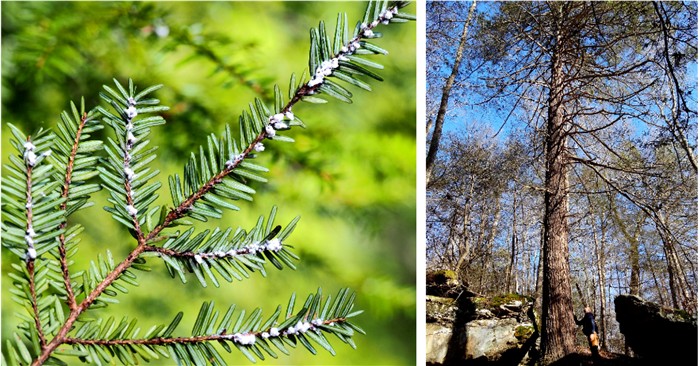State’s Eastern Hemlocks Are Dying Due to Invasive Pest

Close-up photo: A hemlock twig
infested by Hemlock Woolly Adelgid.
Second photo: Chris Smith is standing next to an Eastern Hemlock at Right Fork of Elisha Creek in Leslie County Photos: Kentucky Heartwood
BEREA, KY – Conservation organization Kentucky Heartwood has published a new website, www.hopeforhemlocksky.org, to provide Kentucky landowners with information and tools to help them protect eastern hemlock trees on their property from dying as a result of infestations of hemlock woolly adelgid. Hemlock woolly adelgid (HWA) is an invasive insect from Japan that infests eastern hemlocks, causing the trees to die in as few as four years. To date, little work has been done to help Kentucky landowners save their hemlocks.
“Hemlocks are vital to the health of our forests, and they're disappearing in front of our eyes,” said Kentucky Heartwood Hemlock Program Coordinator, Austin Williams. “We hope that this website will help landowners save hemlock trees on their land before it’s too late,” Williams added.
Hemlock woolly adelgid was first identified in Kentucky in 2006, and has since spread throughout eastern Kentucky. It is anticipated that hemlock trees not protected with a specific chemical treatment in the next few years will not survive. In some parts of the state, particularly in far southern and southeastern counties, many hemlock trees are already dead or dying.
The currently preferred treatment is a careful, dosed application of the chemical imidacloprid at the base of each tree. Treatments last for about four years, and cost about $1 per tree. Biological control through the release of beetles that eat HWA has been tried with mixed results. Other research is underway to find long-term solutions.
Approximately 80,000 trees, or about 0.1% of Kentucky’s hemlocks, have been treated so far on state and federal lands in the Commonwealth. However, shrinking budgets and shifting priorities within the U.S. Forest Service and Kentucky Division of Forestry – the agencies tasked with treating hemlocks on public land – are putting treatment programs at risk.
“We really need all hands on deck right now,” said Jim Scheff, Director of Kentucky Heartwood. “This is a true crisis, and the window for doing something about it is quickly closing.”
Kentucky Heartwood was founded in 1992, with a mission to protect and restore the integrity, stability, and beauty of Kentucky’s native forests and biotic communities through research, education, advocacy, and community engagement.











